Natural Vegetation | Geography Optional for UPSC PDF Download
Natural Vegetation of India
- Natural vegetation in a particular location is significantly influenced by factors such as climate, soil, and topography. Among these, climate plays a crucial role, with rainfall and temperature being the primary determinants.
- The type of vegetation in a region largely depends on the annual amount of rainfall it receives. For instance, areas with high rainfall are likely to have dense forests, while those with low rainfall may have grasslands or deserts.
- Temperature is another critical factor, especially in hilly regions like the Himalayas and areas with an elevation of more than 900 meters. As the altitude increases, the temperature decreases, causing changes in the vegetation cover. In the Himalayan region, the vegetation shifts from tropical to sub-tropical, temperate, and ultimately alpine as one moves to higher altitudes.
- Soil also plays a significant role in determining the natural vegetation of a region, although its impact may not be as widespread as climate. For example, mangrove forests and swamp forests are primarily influenced by the type of soil in the area.
- Finally, topography can also contribute to the type of vegetation in certain locations. Examples of topography-driven vegetation include alpine flora and tidal forests, which are shaped by the terrain and elevation of the region.

In summary, the natural vegetation of a place is primarily influenced by climate, with rainfall and temperature being the major factors. Soil and topography also play important roles in determining the type of vegetation in specific regions.
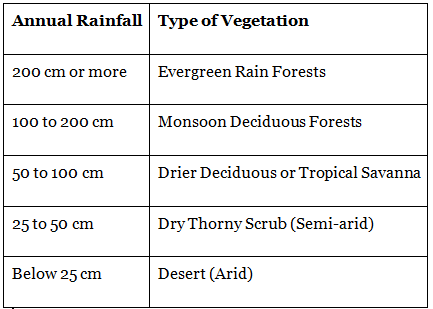
Classification of Natural Vegetation of India
- Classification of Natural Vegetation of India is primarily based on spatial and annual variations in rainfall. Temperature, soil and topography are also considered.
- India’s vegetation can be divided into 5 main types and 16 sub-types as given below.
- Moist Tropical Forests
- Tropical Wet Evergreen
- Tropical Semi-Evergreen
- Tropical Moist Deciduous
- Littoral and Swamp
- Dry Tropical Forests
- Tropical Dry Evergreen
- Tropical Dry Deciduous
- Tropical Thorn
- Montane Sub-tropical Forests
- Sub-tropical broad leaved hill
- Sub-tropical moist hill (pine)
- Sub-tropical dry evergreen
- Montane Temperate Forests
- Montane Wet Temperate
- Himalayan Moist Temperate
- Himalayan Dry Temperate
- Alpine Forests
- Sub-Alpine
- Moist Alpine scrub
- Dry Alpine scrub
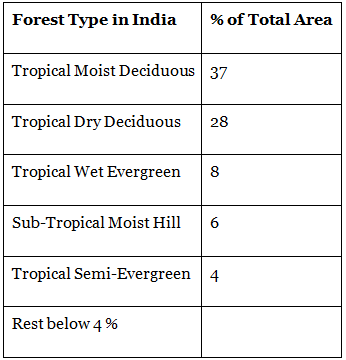
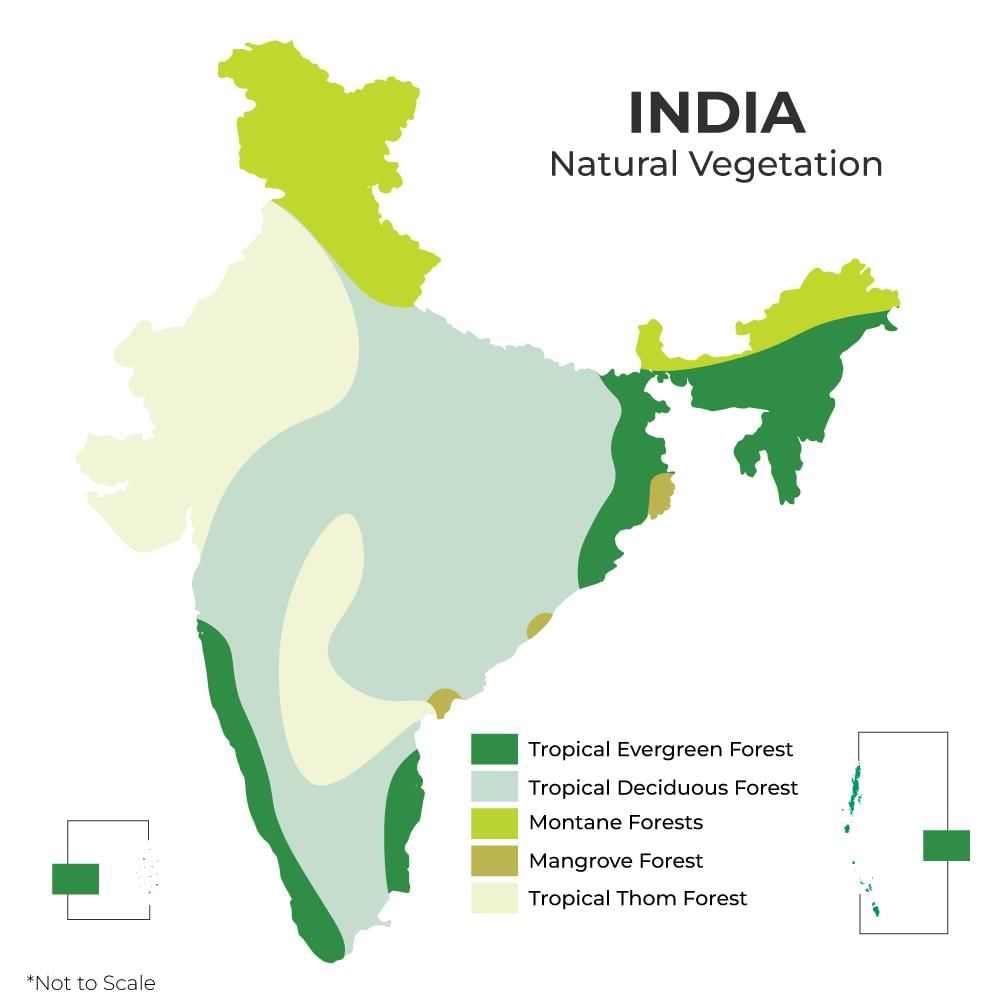
1. Moist Tropical Forests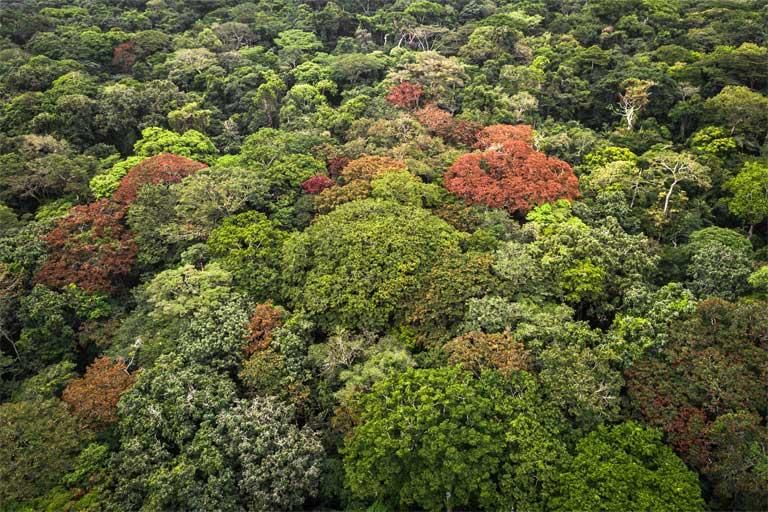
(i) Tropical Wet Evergreen Forests or Rain Forests
Climatic Conditions
- Annual rainfall exceeds 250 cm
- The annual temperature is about 25°-27°C
- The average annual humidity exceeds 77 per cent and
- The dry season is distinctly short.
Characteristics
- Evergreen: Due to high heat and high humidity, the trees of these forests do not shed their leaves together.
- Mesosphytic: Plants adopted to neither too dry nor too wet type climate.
What are mesophytes?
- Mesophytes are a type of plant that grows in environments with moderate levels of moisture, existing between the extremes of hydrophytic plants, which grow in water or saturated soil, and xerophytic plants, which grow in extremely dry soil. They are commonly found in areas with average to warm temperatures and soil that is neither too wet nor too dry.
- These plants can often grow quite tall, reaching heights of 45 to 60 meters. When viewed from above, the foliage of mesophytes forms a dense canopy, broken only by large rivers or areas cleared for cultivation. This thick canopy of leaves creates a layered appearance, as many plants, such as epiphytes, compete for sunlight by growing upwards.
- Due to the dense canopy, sunlight has difficulty reaching the ground, resulting in less undergrowth in these environments. The undergrowth that does exist is typically composed of plants like bamboos, ferns, climbers, and orchids. From an aerial perspective, the dense canopy of mesophytes appears like a lush, green carpet.
Distribution
- Western side of the Western Ghats (500 to 1370 metres above sea level).
- Some regions in the Purvanchal hills.
- In the Andaman and Nicobar Islands.
Timber
- Timber found in hardwood forests is characterized by its fine-grained, hard, and long-lasting properties. This type of timber is highly valuable commercially; however, it is difficult to extract due to factors such as dense undergrowth, the absence of pure stands, and limited transportation facilities.
- To better understand the challenges faced by the lumbering industry in these conditions, one can refer to previous posts discussing climatic regions, specifically those focusing on equatorial rainforests (where hardwood is found) and taiga climates (where softwood is found).
- Some notable tree species found in hardwood forests include mahogany, mesua, white cedar, jamun, canes, and bamboo, among others.
(ii) Tropical Semi-Evergreen Forests
- They are transitional forests between tropical wet evergreen forests and tropical deciduous forests.
- They are comparatively drier areas compared to tropical wet evergreen forests.
Climatic Conditions
- Annual rainfall is 200-250 cm
- Mean annual temperature varies from 24°C to 27°C
- The relative humidity is about 75 per cent
- The dry season is not short like in tropical evergreen forests.
Distribution
- Western coast
- Assam
- Lower slopes of the Eastern Himalayas
- Odisha and
- Andamans
Characteristics
- Semi-evergreen forests are not as dense as wet evergreen forests and tend to have a more social structure, with trees and plants living in groups or colonies. These forests are home to a wide variety of species, making them rich in biodiversity.
- The trees in semi-evergreen forests often have buttressed trunks, providing extra support and stability, and are covered with numerous epiphytes or plants that grow on other plants.
- Some of the notable tree species found in these forests include laurel, rosewood, and mesua in the Western Ghats, as well as white cedar, Indian chestnut, champa, and mango in the Himalayan region. Additionally, thorny bamboo can be found in the Western Ghats semi-evergreen forests.
Timber
- Hardwood: Similar to that in tropical evergreen forests except that these forests are less dense with more pure stands (timber industry here is better than in evergreen forests).
(iii) Tropical Moist Deciduous Forests
Climatic Conditions
- Annual rainfall 100 to 200 cm.
- Mean annual temperature of about 27°C
- The average annual relative humidity of 60 to 75 per cent.
- Spring (between winter and summer) and summer are dry.
Characteristics
- The trees drop their leaves during the spring and early summer when sufficient moisture is not available.
- The general appearance is bare in extreme summers (April-May).
- Tropical moist deciduous forests present irregular top storey [25 to 60 m].
- Heavily buttressed trees and fairly complete undergrowth.
- These forests occupy a much larger area than the evergreen forests but large tracts under these forests have been cleared for cultivation.
Distribution
- Belt running along the Western Ghats surrounding the belt of evergreen forests.
- A strip along the Shiwalik range including terai and bhabar from 77° E to 88° E.
- Manipur and Mizoram.
- Hills of eastern Madhya Pradesh and Chhattisgarh.
- Chota Nagpur Plateau.
- Most of Odisha.
- Parts of West Bengal and
- Andaman and Nicobar islands.
Timber
- These provide valuable timer like Teak.
- The main species found in these forests are teak, sal, laurel, rosewood, amla, jamun, bamboo, etc.
- It is comparatively easy to exploit these forests due to their high degree of gregariousness (more pure stands).
(iv) Littoral and Swamp Forests
- Littoral and swamp forests are unique ecosystems that can thrive in both fresh and brackish water, which is a mixture of seawater and freshwater found in estuaries with a salinity range of 0.5 to 35 ppt. These forests are typically found in areas such as deltas, estuaries, and creeks that are subject to tidal influences, often referred to as delta or tidal forests.
- Littoral forests, which are related to the shores of the sea or a lake, can be found in various locations along the coast. On the other hand, swamp forests are predominantly located in the deltas of major rivers such as the Ganga, the Mahanadi, the Godavari, the Krishna, and the Cauvery.
- Mangroves are a prominent feature of these forests, growing densely along the coastline in sheltered estuaries, tidal creeks, backwaters, salt marshes, and mudflats. These mangroves serve as a valuable source of fuel wood. The most notable and densest mangrove forest is the Sunderbans in the Ganga delta, where the primary species is Sundri (Heritiera).
Timber
- It provides hard and durable timber which is used for construction, building purposes and making boats.
- The important species found in these forests are Sundri, agar, rhizophora, screw pines, canes and palms, etc.
2. Dry Tropical Forests(i) Tropical Dry Evergreen Forests
Distribution
- Along the coasts of Tamil Nadu.
Climatic Conditions
- Annual rainfall of 100 cm [mostly from the north-east monsoon winds in October – December].
- Mean annual temperature is about 28°C.
- The mean humidity is about 75 per cent.
- The growth of evergreen forests in areas of such low rainfall is a bit strange.
Characteristics
- Short statured trees, up to 12 m high, with complete canopy.
- Bamboos and grasses not conspicuous.
- The important species are jamun, tamarind, neem, etc.
- Most of the land under these forests has been cleared for agriculture or casuarina plantations.
Casuarina plantation
- It resembles feathery conifer in general appearance.
- They are rapid-growing, carefree species for sites and climates as varied as coastal sand dunes, high mountain slopes, hot humid tropics, and semi-arid regions.
- They have the ability to fix atmospheric nitrogen. It grows 15 to 25 metres in height on an average.
Distribution
- Casuarina is the most popular farm forestry in the states of Andhra Pradesh, Tamil Nadu, West Bengal, Odisha, Maharashtra, Gujarat, and Karnataka.
Benefits
- Enhanced protection from natural disasters: Line planting can help reduce the damage caused by natural calamities, such as storms and floods, by acting as a barrier and absorbing some of the impact.
- Wind force control: Planting vegetation in coastal areas can help control wind force, reducing wind erosion and providing a more stable environment for other plants and wildlife.
- Tourism promotion: The ornamental appearance of line planting can attract tourists, boosting the local economy and promoting a greater appreciation for the environment.
- High-quality firewood: The wood produced from line planting can be used as top-quality firewood, providing a sustainable and eco-friendly source of energy.
- Paper production: The wood from line planting is suitable for paper pulp and can be used as a raw material for manufacturing various types of paper, such as writing, printing, and wrapping paper.
- Medicinal value: Line planting can also have significant medicinal value, with certain plants containing properties that can be used to treat various ailments and improve overall health.
Wasteland Development
- The characteristics which make it a suitable species for wasteland development include adaptability to wide range of habitats, fast growth, salt tolerant, drought resistant, ability to reclaim land and stabilize sand dunes.
- Intercrops such as groundnut, cucumber, watermelons, sesamum, and pulses can also be raised along with the plantation.
(ii) Tropical Dry Deciduous Forests
Climatic Conditions
- Annual rainfall is 100-150 cm.
Characteristics
- These are similar to moist deciduous forests and shed their leaves in dry season.
- The major difference is that they can grow in areas of comparatively less rainfall.
- They represent a transitional type – moist deciduous on the wetter side and thorn forests on the drier side.
- They have closed but uneven canopy.
- The forests are composed of a mixture of a few species of deciduous trees rising up to a height of 20 metres.
- Undergrowth: Enough light reaches the ground to permit the growth of grass and climbers.
Distribution
- They occur in an irregular wide strip running from the foot of the Himalayas to Kanniyakumari except in Rajasthan, Western Ghats and West Bengal.
- The important species are teak, axlewood, rosewood, common bamboo, red sanders, laurel, satinwood, etc.
- Large tracts of this forest have been cleared for agricultural purposes.
- These forests have suffer from over grazing, fire, etc.
(iii) Tropical Thorn Forests
Climatic Conditions
- Annual rainfall less than 75 cm.
- Humidity is less than 50 per cent.
- Mean temperature is 25°-30°C.
Characteristics
- The trees are low (6 to 10 metres maximum) and widely scattered.
- Acacias and Euphorbias are very prominent.
- The Indian wild date is common. Some grasses also grow in the rainy season.
Distribution
- Rajasthan, south-western Punjab, western Haryana, Kachchh and neighbouring parts of Saurashtra.
- Here they degenerate into desert type in the Thar desert.
- Such forests also grow on the leeside of the Western Ghats covering large areas of Maharashtra, Karnataka, Telangana, Andhra Pradesh and Tamil Nadu.
- The important species are neem, babul, cactii, etc.
3. Montane Sub-Tropical Forests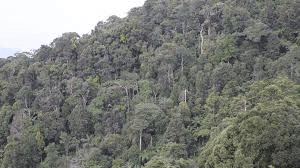
(i) Sub-tropical Broad-leaved Hill Forests
Climatic conditions
- Mean annual rainfall is 75 cm to 125 cm.
- Average annual temperature is 18°-21°C.
- Humidity is 80 per cent.
Distribution
- Eastern Himalayas to the east of 88°E longitude at altitudes varying from 1000 to 2000 m.
Characteristics
- Forests of evergreen species.
- Commonly found species are evergreen oaks, chestnuts, ash, beech, sals and pines.
- Climbers and epiphytes [a plant that grows non-parasitically on a tree or other plant] are common.
- These forests are not so distinct in the southern parts of the country. They occur only in the Nilgiri and Palni hills at 1070-1525 metres above sea level.
- It is a “stunted rain-forest” and is not so luxuriant as the true tropical evergreen.
- The higher parts of the Western Ghats such as Mahabaleshwar, the summits of the Satpura and the Maikal Range, highlands of Bastar and Mt. Abu in the Aravali Range carry sub-types of these forests.
(ii) Sub-tropical Moist Pine Forests
Distribution
- Western Himalayas between 73°E and 88°E longitudes at elevations between 1000 to 2000 metres above sea level.
- Some hilly regions of Arunachal Pradesh, Manipur, Naga Hills and Khasi Hills.
Timber
- Chir or Chil is the most dominant tree which forms pure stands.
- It provides valuable timber for furniture, boxes and buildings.
- It is also used for producing resin and turpentine.
(iii) Sub-tropical Dry Evergreen Forests
Distribution
- Found in the Bhabar, the Shiwaliks and the western Himalayas up to about 1000 metres above sea level.
Climatic Conditions
- Annual rainfall is 50-100 cm (15 to 25 cm in December-March).
- The summers are sufficiently hot and winters are very cold.
Characteristics
- Low scrub forest with small evergreen stunted trees and shrubs.
- Olive, acacia modesta and pistacia are the most predominant species.
4. Montane Temperate Forests
(i) Montane Wet Temperate Forests
Climatic Conditions
- Grows at a height of 1800 to 3000 m above sea level
- Mean annual rainfall is 150 cm to 300 cm
- Mean annual temperature is about 11°C to 14°C and the
- Average relative humidity is over 80 per cent.
Distribution
- Higher hills of Tamil Nadu and Kerala, in the Eastern Himalayan region.
Characteristics
- These are closed evergreen forests. Trunks have large girth.
- Branches are clothed with mosses, ferns and other epiphytes.
- The trees rarely achieve a height of more than 6 metres.
- Deodar, Chilauni, Indian chestnut, birch, plum, machilus, cinnamomum, litsea, magnolia, blue pine, oak, hemlock, etc. are important species.
(ii) Himalayan Moist Temperate Forests
Climatic Conditions
- Annual rainfall varies from 150 cm to 250 cm
Distribution
- Occurs in the temperate zone of the Himalayas between 1500 and 3300 metres.
- Cover the entire length of this mountain range in Kashmir, Himachal Pradesh, Uttarakhand, Darjeeling and Sikkim.
Characteristics
- Mainly composed of coniferous species.
- Species occur in mostly pure strands.
- Trees are 30 to 50 m high.
- Pines, cedars, silver firs, spruce, etc. are most important trees.
- They form high but fairly open forest with shrubby undergrowth including oaks, rhododendrons and some bamboos.
Timber
- It provides fine wood which is of much use for construction, timber and railway sleepers.
(iii) Himalayan Dry Temperate Forests
Climatic Conditions
- Precipitation is below 100 cm and is mostly in the form of snow.
Characteristics
- Coniferous forests with xerophytic shrubs in which deodar, oak, ash, olive, etc are the main trees.
Distribution
- Such forests are found in the inner dry ranges of the Himalayas where south-west monsoon is very feeble.
- Such areas are in Ladakh, Lahul, Chamba, Kinnaur, Garhwal and Sikkim.
5. Alpine Forests
These forests are typically found at elevations between 2,900 and 3,500 meters. They can be categorized into three distinct types: (1) sub-alpine forests, (2) moist alpine scrub, and (3) dry alpine scrub.
- Sub-alpine forests are located in the lower regions of alpine scrub and grasslands. They consist of a mix of coniferous and broad-leaved trees, with conifers reaching heights of around 30 meters and broad-leaved trees growing up to 10 meters. Notable species in this type of forest include fir, spruce, and rhododendron.
- Moist alpine scrub is characterized by a dense, low, evergreen growth of vegetation, including rhododendron and birch. This type of scrub is found at elevations starting from 3,000 meters and extends up to the snowline.
- Dry alpine scrub, on the other hand, is found in higher elevations, above 3,500 meters, and is situated within the dry zone. This type of scrub features xerophytic (adapted to dry environments) dwarf shrubs. Important species found in dry alpine scrub include juniper, honeysuckle, and Artemesia.
Conclusion
In conclusion, the natural vegetation of India is diverse and complex, influenced by factors such as climate, soil, and topography. India's vegetation can be categorized into five main types: moist tropical forests, dry tropical forests, montane sub-tropical forests, montane temperate forests, and alpine forests. Each type of vegetation is further divided into sub-types, each with distinct characteristics, distribution, and timber value. The preservation and management of India's rich and varied natural vegetation is crucial for maintaining the ecological balance, supporting biodiversity, and providing valuable resources for the country's population.|
303 videos|636 docs|252 tests
|
FAQs on Natural Vegetation - Geography Optional for UPSC
| 1. What are the major types of natural vegetation found in India? |  |
| 2. How does climate influence the natural vegetation in India? |  |
| 3. What is the significance of natural vegetation in India? |  |
| 4. What are the threats to natural vegetation in India? |  |
| 5. How can conservation of natural vegetation be promoted in India? |  |
















